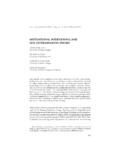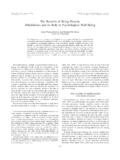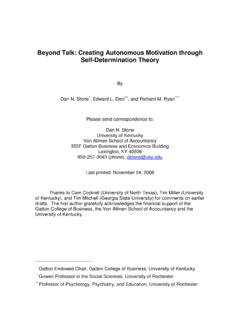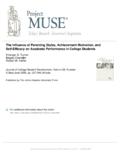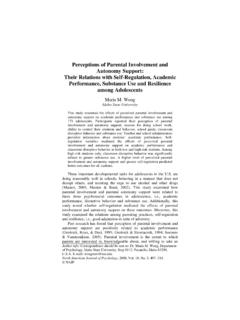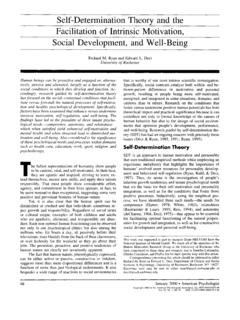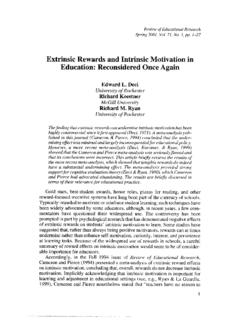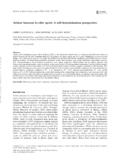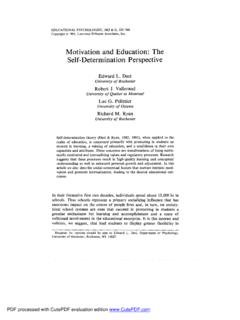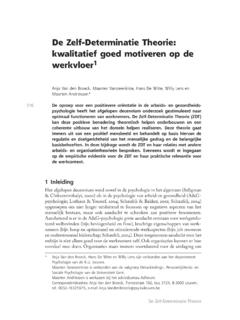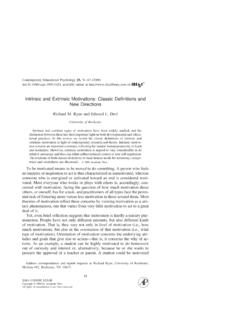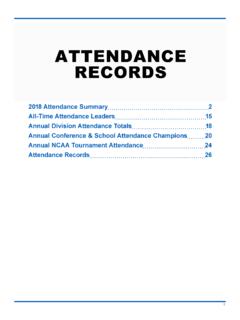Transcription of TARGET ARTICLE The “What” and “Why” of Goal Pursuits ...
1 Psychological Inquiry Copyright 2000 by 2000, Vol. 11, No. 4, 227 268 Lawrence Erlbaum Associates, Inc. TARGET ARTICLE . The What and Why of Goal Pursuits : Human Needs and the Self-Determination of Behavior Edward L. Deci and Richard M. Ryan Department of Psychology University of Rochester Self-determination theory (SDT) maintains that an understanding of human motiva- tion requires a consideration of innate psychological needs for competence, auton- omy, and relatedness. We discuss the SDT concept of needs as it relates to previous need theories, emphasizing that needs specify the necessary conditions for psycholog- ical growth, integrity, and well-being.
2 This concept of needs leads to the hypotheses that different regulatory processes underlying goal Pursuits are differentially associ- ated with effective functioning and well-being and also that different goal contents have different relations to the quality of behavior and mental health, specifically be- cause different regulatory processes and different goal contents are associated with differing degrees of need satisfaction. Social contexts and individual differences that support satisfaction of the basic needs facilitate natural growth processes including intrinsically motivated behavior and integration of extrinsic motivations, whereas those that forestall autonomy, competence, or relatedness are associated with poorer motivation, performance, and well-being.
3 We also discuss the relation of the psycho- logical needs to cultural values, evolutionary processes, and other contemporary mo- tivation theories. Most contemporary theories of motivation assume types of goals have different behavioral and affective that people initiate and persist at behaviors to the ex- consequences. tent that they believe the behaviors will lead to desired Like these other theories, self-determination theory outcomes or goals. Beginning with the work of Lewin (SDT; Deci & Ryan, 1980, 1985b, 1991) has differen- (1936) and Tolman (1932), this premise has led moti- tiated the concept of goal-directed behavior, yet it has vation researchers to explore the psychological value taken a very different approach.
4 SDT differentiates the people ascribe to goals ( , T. Kasser & Ryan, 1996; content of goals or outcomes and the regulatory pro- Vroom, 1964), people's expectations about attaining cesses through which the outcomes are pursued, mak- goals ( , Abramson, Seligman, & Teasdale, 1978; ing predictions for different contents and for different Bandura, 1989; Rotter, 1966), and the mechanisms that processes. Further, it uses the concept of innate psy- keep people moving toward selected goals ( , chological needs as the basis for integrating the differ- Carver & Scheier, 1998).
5 Entiations of goal contents and regulatory processes Whereas initially this approach assumed that any and the predictions that resulted from those differentia- two equally valued goals with the same expectancies tions. Specifically, according to SDT, a critical issue in for attainment would yield the same quality of perfor- the effects of goal pursuit and attainment concerns the mance and affective experience, recent work on degree to which people are able to satisfy their basic goal-directed behavior has begun to distinguish psychological needs as they pursue and attain their val- among types of goals or outcomes.
6 Researchers have, ued outcomes. for example, contrasted ability-development goals The concept of needs was once widely employed in with ability-demonstration goals (Dweck, 1986; empirical psychology to organize the study of motiva- Nicholls, 1984) and approach goals with avoidance tion. Although variously defined at the physiological goals (Carver & Scheier, 1998; Elliot & Church, or psychological levels and as innate or learned, the 1997; Higgins, 1996), suggesting that the different concept of needs specified the content of motivation DECI & RYAN.
7 And provided a substantive basis for the energization of behaviors such as curious exploration, investigatory and direction of action. Beginning around the 1960s, manipulation, vigorous play, and other spontaneous however, the dramatic shift toward cognitive theories activities that had no apparent ties to the dynamics of led to the concept of needs being repudiated and re- drive reduction. Indeed, it was partly the drive theo- placed by the concept of goals as the dominant motiva- rists' attempts to account for such behaviors that gave tional concept.
8 The focus became the processes of goal rise to the recognition of intrinsic motivation (see selection and pursuit rather than the content of the White, 1959) and ultimately led to specification of the goals being selected and pursued. The concept of va- psychological needs. lence (or psychological value) of outcomes was de- The second tradition focusing on needs stems fined functionally (and thus was not related to need from the work of Murray (1938). Murray addressed satisfaction), much as the concept of reinforcement needs at the psychological rather than physiological had been defined functionally in operant psychology level and viewed them primarily as acquired rather (B.)
9 F. Skinner, 1953), ignoring the needs that had pro- than innate. In this approach the concept of needs vided the underpinning of reinforcements in drive the- was very broadly construed, as we see here in ories ( , Hull, 1943). Murray's oft-cited definition: Since the time of the shift toward cognitive theories, most motivation theorists remained unwilling to con- A need is a construct (a convenient fiction or hypothet- sider needs, focusing instead on goal-related efficacy. ical concept) that stands for a force (the physico-chem- SDT has, in contrast, maintained that a full understand- ical nature of which is unknown) in the brain region, a ing not only of goal-directed behavior, but also of psy- force that organizes perception, apperception, intellection, conation and action in such a way as to chological development and well-being, cannot be transform in a certain direction an existing, unsatisfy- achieved without addressing the needs that give goals ing situation.
10 (pp. 123 124). their psychological potence and that influence which regulatory processes direct people's goal Pursuits . Indeed, this definition is so broad that one could substi- Specifically, in SDT, three psychological needs for tute terms like motive, desire, or goal for need without competence, relatedness, and autonomy are consid- losing any meaning. By this definition, almost any- ered essential for understanding the what ( , content) thing that moves one to action is a need, a fact that is and why ( , process) of goal Pursuits .
